October 28, 2010
By Bill Winke
What you can learn from off-season sightings.
By Bill Winke
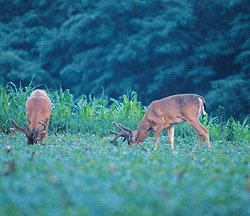 July and early August is the very best time to see the biggest bucks in your hunting area. However, that doesn't mean they will still be around come hunting season. |
I can't wait until November. Not only do I love the possibility of shooting a big buck with my bow, I really like the adrenaline rush that comes from just seeing a monster from my stand. I just want to gawk at something that makes my jaw drop. Oh boy, that is exciting stuff! If I should somehow shoot the deer, that would just be icing on the cake.
For the past 18 Novembers, I have gone into the season with a singular goal -- the rush of seeing a truly big buck. In 13 of the following Januaries, I've looked back with a twinge of disappointment. Most years I never see a whopper. Sure, I see great deer, just nothing that makes my eyes bug out and my heart turn into a jet turbine. Let's face it; mature bucks are just hard to see during hunting season.
Advertisement
November reality may be harsh, but summer is always sweet. July is when hope springs eternal. I've seen many dozens of mature bucks during the summer. Last summer was a classic example. I have started producing an online hunting show (you can see it at www.midwestwhitetail.com), and as a result, my friends and I have started filming summer bucks. We literally filmed dozens of monsters. Heck, I filmed at least two (maybe three) that were over 180 inches.
Those bucks were not nearly as hard to see during the summer. We found them hanging around alfalfa, clover and soybean fields, gorging themselves in broad daylight. Those sightings promised great adventure for the coming fall.
Advertisement
As it turned out, those summer bucks were merely taunting us like a Terrell Owens end zone dance. Through their very presence, they said, "We are here, but you will never see us during the season." OK, maybe things were not quite that bleak; never is a strong word. But of the 11 bucks on my hit list going into last season, only four were seen by myself or my guests during three months of hunting. We were lucky enough to kill two of those four.
The point is, with all the time we spent hunting those areas, fully seven of the 11 target bucks either evaporated or somehow managed to elude all of us.
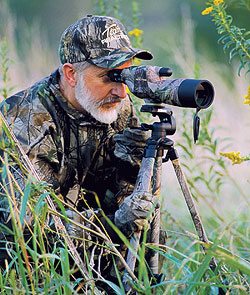 The best way to scout during the summer is with a spotting scope so that you can keep your distance. |
The difference between a buck's summer range and fall range has confounded me many times, but never more than last year. I finally had all the tools in place to do a thorough scouting job, gave patterning a high priority and hunted very hard. The result was still the same; they disappeared.
Experiences from 2003 also serve to illustrate these broad and frustrating differences between summer and fall. Throughout July, I watched two great bucks near one of my hunting areas. They had distinctive antlers. One had big drop tines off his G-2s and the other was wide. I recognized them the instant I saw them. In 10 trips to the area that summer, I saw the drop-tine buck six times and the wide one three times.
I was just sure I would see one or both of these impressive deer come hunting season, and I even had the audacity to hope I would arrow one or even both.
I hunted hard and as carefully as possible for the entire month of November and spent all that time in the same area where I had seen the two bucks. I never saw either but kept a positive mind-set; I was certain one of them would show up on a food plot during the late season. So, I hunted nearly every evening of the late season too. I saw many young bucks and a couple middle-aged shooters (out of range), yet I never caught a single glimpse of those two old trophies.
Then, a month later, I was talking to a fellow who bowhunts a piece of ground three miles away from where I was hunting. He identified the drop-tine buck down to the smallest detail. He recounted, blow-by-blow, how the buck had given him the slip three times in November. Great stories, but they were supposed to have been my stories. No one I spoke with reported seeing the wide buck; he simply vanished after July.
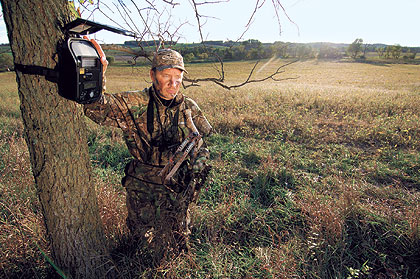 To learn what the deer are doing in your hunting area after the transition from summer to fall range, incorporate trail cameras into your scouting efforts. You may be surprised how many of the bucks you had been seeing have disappeared and how many new bucks have shown up. |
Clearly, summer ranges are not necessarily fall ranges, and a deer that is highly visible in July may not be seen again until the following July. Just because you see a big buck on a certain field during the summer, that doesn't mean he will still be in the area come fall or that he will be moving openly.
On the other hand, I know of two other bucks on one farm that remained within a few hundred yards of where we watched them all summer. Jim and Larry shot those bucks (a 185-incher and a monstrous 245-incher) within 100 yards of where they hung out all summer.
The point of all this is simple: there is definitely some value to summer scouting, but you have to take it with a grain of salt. Understand what you are seeing. Don't read too much or too little into it.
The Boys Of Summer
It is hard to know exactly what mature bucks do during the fall. For sure, they breed a few does and they must eat and sleep -- but where? Even top research biologists still have many more questions than answers related to these deer. Part of the problem is their lack of visibility -- most of the bucks that live to old age have reclusive personalities.
And part of the problem, according to researcher Dr. Grant Woods, is a lack of scientific tracking data for mature bucks. Simply put, they are exceedingly difficult to catch and collar in a truly wild setting.
That said, there is little question what mature bucks do during the summer. They feed openly and they feed heavily. Watch a few high-protein food sources during the last hour of daylight for several evenings from mid-July through mid-August and you'll see more mature bucks than at any other time of the year.
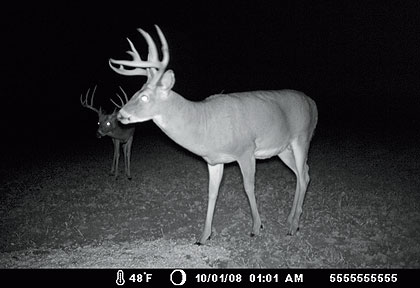 The buck in the background is the one that Winke shot Nov. 16, roughly 300 yards from where this photo was taken in early October. If you can get several pictures of one buck in a certain area, the odds are pretty good that you can kill him there. |
After these bucks shed their velvet, they may or may not move to a different range. This is where it gets tricky. Bucks form bachelor groups during the summer and seem to enjoy each other's company. By the time their testosterone levels increase enough to initiate velvet shedding, they are beginning to see one another as adversaries. In fact, soon they won't tolerate each other at all.
Some of the bucks disperse. Some stay. It is almost impossible to know which ones will stay and which ones will go without the benefit of last fall's scouting and hunting experience. A buck's fall range may be the same nearly every year of his life, but it won't necessarily be the same as his summer range. If you remember nothing else from this article, please remember that.
I have hunted several Septembers in Montana and Alberta and noticed that summer patterns hold up well until the bucks shed their velvet. Then, there is a period of about two weeks when everything gets mixed up before the bucks settle into their fall patterns.
If you have the chance to hunt bucks in velvet, summer sightings are the very best form of scouting. If not, the summer work is fun but should not be the sole basis for your upcoming season.
Successful Scouting
Traditional scouting: Beyond mid-spring, there is very little you can learn by walking the woods. Vegetation makes it tough to see the lay of the land, and any buck sign from the previous fall, including most rubs, have grown over and disappeared. It is also a time when ticks flourish in many parts of the whitetail's range.
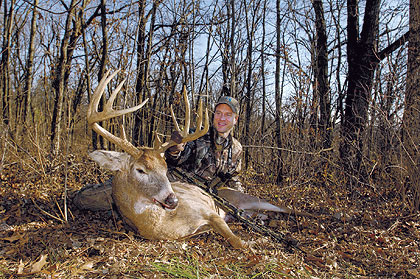 Winke shot this buck on Nov. 16, but realized afterwards that he had actually gotten some trail cam pictures of the buck in early October about 300 yards away. This is one of two bucks from the pre-season hit list that he and his friends were able to shoot last season. |
Then there is always the fun of climbing through poison oak vines to put up your stands.
That experience will stay with you for a while, literally. I'm not a big fan of traditional scouting during the summer. Long-range scouting is much better.
Observation: Almost everything valuable you can learn during the summer you can gather from the small end of a spotting scope. Keep your distance and choose your vantage points carefully so you can exit the area at dusk. Watch the back corners of high-protein feeding areas and note any emerging patterns.
Close-range scouting: I shy away from any close-range contact with bucks during summer because I don't want to risk making them uncomfortable. However, I have several friends who love to film deer at this time. They put out ground blinds specifically for this purpose, and they have recorded some incredible, close-up footage of all sorts of summer deer behavior. However, this form of scouting carries a high risk of further educating the deer.
Though bucks aren't as sensitive to man-made dangers during the summer as they are during the fall, they are still mature deer, and being such, won't tolerate us if they know we are close at hand. You must conduct close-range scouting with just as much caution as you would use when actually hunting the same area during the fall. Specifically, you need to play the wind, pay close attention to your entry and exit routes and arrange a diversion to get out of the area at dusk.
Finding Fall Patterns
OK, now I am going to take you the rest of the way through last season. After the bucks began to disappear from the open fields in early September, I took a little break from filming. Early in October, I began to put out trail cameras over small piles of corn, a practice that is legal in my area. I ran four cameras in eight locations for the next three weeks, quitting with the camera work a week before I started hunting in late October.
I got hundreds of buck photos, but only two of the bucks I had picked out that summer were among them. That's right, nine out of my 11 target bucks were no-shows. Talk about discouraging! I entered the season with far less hope of shooting one of my hit-list bucks than I had back in July. As the season played out, we ended up shooting (or shooting at) several of the bucks we had photographed, but we only saw two from the hit list.
It was a good reality check for me, and I learned a very important lesson. The very best way to determine which bucks you are really hunting is to run a trail camera after the summertime bachelor groups break up. It is only after the bucks settle into their fall ranges that you will have a real sense of the "buck inventory" in your particularly area.
